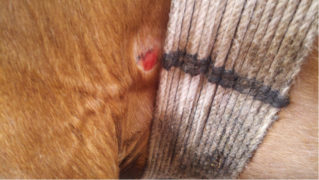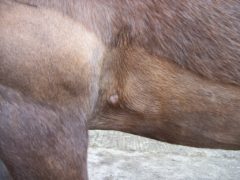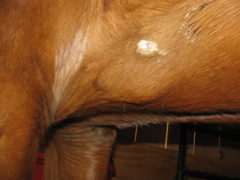Saddle Fit and “Girth Galls”
‘Tis the season’ for girth itch and girth galls
Girth itch – a nasty little infection similar to ringworm that occurs typically this time of year – hot, sweaty, humid… It typically affects younger horses or those who are immuno-suppressed, can be spread by dirty tack or using brushes on multiple horses. It’s a pain… Starts as dandruff like raised flakes in the girth area, then spreads, and eventually can turn into open wounds.
This can be treated medically, but it is typically caused/worsened by an ill-fitting girth that chafes. You may try different types of girths to see if there is any positive effect, but this can happen to you regardless if you use a $250 leather girth or a $30 synthetic girth. It could possibly be a reaction to either the tanning process or cleaner used, or perhaps because of ‘dirt’ (sand or the like) getting in between the girth and your horse’s skin, but in reality part of the problem might simply be the shape and design of the girth you’re using.
We have found the best girth to be one that is shaped like this:

It is about 5-8″ wide in the middle, slightly cut out in the elbow area, and is super soft and totally smooth on the bottom so no dirt gets in.

Treatment of Girth Galls
If the problem has progressed to an open sore, sponge the sore and area around it with saline solution and cover it with a soothing ointment or cream. Many people like creams or lotions with calendula or aloe vera. I have found that zinc oxide (as in diaper cream!) works well. You may also choose to use something with an antibiotic in it. The main goal is to keep the area clean and the skin in good condition. However, whether the sore is open or closed no equipment should be placed over the area until it is healed. It will be uncomfortable for your horse to wear anything over an area that is already sore.
Saddlers use (or should use) mixed or pure chemically tanned leather on saddles and girths, but never on bridles, as this would cause the skin/hair on the horse’s head to flake. Therefore, for bridles we use natural (‘vegetable’) tanned leather. The tanning solution is made out of bark from the oak trees.

The reason for the industry to use chrome, mix-, or chemical tanning is so the sweat won’t penetrate into the girth, (as unfortunately the truth is that most riders do not clean properly their tack, which leads to replacement of tack more often than might actually be necessary with proper care!)
Which is a perfect segue into the next point I want to make – taking proper care of your equipment (and thereby extending its lifespan!).
There are many products on the market to help you take care of your saddle and tack – and regular cleaning and maintenance is just as important as changing the oil on your car or buying new tires. It’s all about safety and keeping your investment working.
It’s highly recommended that you use only oil that is manufactured for use on leather – use baby oil on babies and olive oil in salads, because that’s where they belong.
 If you use any type of soap (glycerine or otherwise) make sure you rinse it off completely. Soap will eventually eat through the leather just as sweat will, so you’re better off just using water if you have nothing else. Get rid of the sweat in any case. (Think of washing your hands – even with glycerine soap, you do rinse it off completely and then apply a conditioning hand lotion). Beeswax cream for saddles works very well as a moisturizing conditioner. We recommend to use oil very sparingly on your saddle and tack, and only on those parts of the saddle or tack that don’t touch you. In some English saddles, excessive use of oil on the seat will actually soak through the laminated layers of the trees (most English saddles are still made using beechwood layers) and loosen the glue to the extent that your tree may be compromised to the point of breakage. We recommend a very light oiling only once when your saddle is new and thereafter to stay with a beeswax conditioning cream to keep the leather supple and looking new.
If you use any type of soap (glycerine or otherwise) make sure you rinse it off completely. Soap will eventually eat through the leather just as sweat will, so you’re better off just using water if you have nothing else. Get rid of the sweat in any case. (Think of washing your hands – even with glycerine soap, you do rinse it off completely and then apply a conditioning hand lotion). Beeswax cream for saddles works very well as a moisturizing conditioner. We recommend to use oil very sparingly on your saddle and tack, and only on those parts of the saddle or tack that don’t touch you. In some English saddles, excessive use of oil on the seat will actually soak through the laminated layers of the trees (most English saddles are still made using beechwood layers) and loosen the glue to the extent that your tree may be compromised to the point of breakage. We recommend a very light oiling only once when your saddle is new and thereafter to stay with a beeswax conditioning cream to keep the leather supple and looking new.
